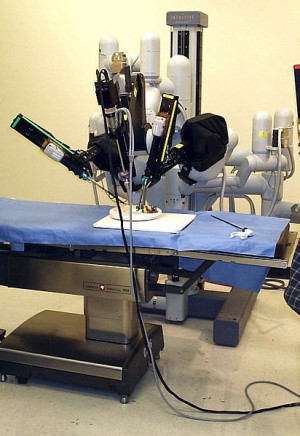Roblog is a weekly column dedicated to understanding the world of robotics. If science fiction is right and the impending robot apocalypse is real, it can’t hurt to be prepared. Come back every Wednesday for a new blog of robot rants.
There seems to be fewer and fewer tasks that humans can still do better than robots. Amongst the robot librarians, pharmacists, and care-takers, another type of robot is becoming popular in an area still considered to be very specialized. As technology improves, more robots are being used in successful surgeries than ever before.

Robot-assisted surgery isn’t a new idea. The first documented use was in 1985, when a PUMA 560 robot assisted in a brain biopsy. The world of robotic surgery was revolutionized, however, in 2000 with the da Vinci Surgery System, the first robot to be approved by the FDA for laproscopic surgery. In 2010, the first all-robot surgery was performed using the da Vinci System and another robot, called McSleepy, at McGill University in Montreal. McSleepy, which has been used in surgeries since 2008, administered anesthesia to the prostatectomy patient. Then the entire surgery was done using the da Vinci System, which allows the doctor to sit at a workstation and maneuver the robot’s 360 degree arms through small ports placed in the patient.
The advantages of robotic assisted surgery seem obvious. Robots have the ability to be more precise and work in smaller spaces than surgeons can and don’t have to worry about fatigue.
“Robots in medicine can provide health care of higher safety and precision, thus ultimately improving outcomes” says Dr. TM Hemmerling of McGill University, although “there is still some work needed to perfect the all robotic approach.”
Many doctors and patients alike are excited about robotic surgery, but there is currently little hard evidence to show whether it is actually more effective than traditional methods. There’s also the issue of cost to consider. The da Vinci System, for example, costs around 1.3 million dollars, in addition to thousands of dollars each year for maintenance.
Whether they are always more effective than humans or not, robots have recently achieved some incredible feats. In February 2012, the first robotic surgery treating lung cancer was completed. This surgical process provides an alternative for those patients that are too high risk for the traditional open chest surgery. Recently, robots have also been of help to gynecological surgeries like hysterectomies, as the increased range of motion of the newer robots helps reduce the risk of accidental damage. Just last week, the first lumbar spinal surgery was performed using the da Vinci Robot, which resulted in less blood loss and a smaller incision for the patient.
Doctors aren’t out of their jobs yet though. Even in robotic surgeries, highly trained doctors are still needed. The robots are still far too expensive for mass use and they have not yet justified their immense cost with significantly better surgical results. As news of successful robot surgeries continues to arise, it’s likely that the use of robots in surgery in a variety of fields will continue to increase. Although the robots aren’t perfect yet, anything that makes surgery easier for doctors to perform and easier for patients to recover from is a step in the right direction.


2 Comments on “Roblog: Robot Surgeries on the Rise”